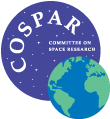
16-20 November, 2009 - Brugge, Belgium
| Session: | Session 3 Space Weather Products and Services (03) |
| Type: | Oral session |
| Date: | 18 November 2009 |
| Time: | 09:00 - 12:30 |
| Chair: | D. Heynderickx |
| Co-chair: | |
| Remarks: | Coffee break at 10:30 |
| Seq | Time | Title | Abs No | ||||
| 1 | 09:00 |
Webservices for Distributed Access to Space Weather Models
Ruhl, Kai; Beltrami, Pablo etamax space GmbH, GERMANY Space weather models have advanced considerably over the last decade, but the access barrier to running these models remains high: Although most models are principally openly available, understanding input/output parameters as well as as the actual process required to run the model is a non-trivial task. A first step for simplifying access to models has been taken by websites such as SPENVIS, where human users can input parameters into a web interface and remotely run the model. However, when results of one model are taken as input to a second model, this procedure again becomes a non-trivial task. Automating a workflow which consists of a chain of several models requires software applications to be written, unless one wishes to perform the workflow manually. To enable this, a logical second step is the provision of software interfaces to space weather models. In this talk, we argue that it is a good approach to keep the model run facility on the server of the model developer, and to provide remote interfaces for software applications. In order to be accessible by a wide range of programming languages and operating systems, web services would be a good choice. Web services are, at the most basic level, XML files being sent to a server both as request and response. Like HTML, they are simply structured and easily understood. Being standardised by the W3C consortium, a high degree of investment safety is given. Web services are widely used in distributed software systems around the world, and to a smaller degree already also in space weather data repositories such as SWENET. In the context of SSA, it will become ever more beneficial for model developers to enable easy invocation of model runs. In maintaining a distributed network topology which lets users access models remotely, organisations can keep control over their implementations and are thus able to deliver the best possible results to their users. Recently started activities aiming at providing services virtual space weather observatories, such as the Vispanet prototypes, will increasingly make use of such distributed access possibilities in the future. |
|||||
| 2 | 09:25 |
WWW.NMDB.EU: The Real-Time Neutron Monitor Database
Klein, Karl-Ludwig1; Steigies, Christian2; Fuller, Nicolas1 1Observatoire de Paris, FRANCE; 2Christian-Albrechts-Universitaet Kiel, GERMANY The Real time database for high-resolution neutron monitor measurements (NMDB) project, supported by the European Commission, is underway to set up a database for European and some non-European neutron monitors. Neutron monitors are still the key tool to measure galactic and solar cosmic rays in the energy range of about 500 MeV to several tens of GeV. The objective of NMDB is to ensure an easy use of the data by astrophysicists and a wide user community interested by space-weather applications. The contribution presents the status and future developments of the project, and illustrates some applications. |
|||||
| 3 | 09:50 |
HELIO - The Heliophysics Integrated Observatory
Bentley, Robert1; Csillaghy, Andre2; Aboudarham, Jean3; Jacquey, Christian4; Hapgood, Mike5; Bocchialini, Karine6; Messerotti, Mauro7; Brooke, John8; Gallagher, Peter9; Fox, Peter10; Hurlburt, Neal11; Roberts, D. Aaron12; Sanchez Duarte, Luis13 1University College London, UNITED KINGDOM; 2Fachhochschule Nordwestschweiz, SWITZERLAND; 3Observatoire de Paris, FRANCE; 4Universite Paul Sabatier Toulouse III, FRANCE; 5Science and Technology Facilities Council, UNITED KINGDOM; 6Universite Paris-Sud XI, FRANCE; 7Istituto Nazionale di Astrofisica, ITALY; 8University of Manchester, UNITED KINGDOM; 9Trinity College Dublin, IRELAND; 10 Rensselaer Polytechnic Institute, UNITED STATES; 11Lockheed Martin Advanced Technology Center, UNITED STATES; 12NASA Goddard Space Flight Center, UNITED STATES; 13European Space Agency, SPAIN Heliophysics explores the Sun-Solar System connection and spans the existing domains of solar, heliospheric, magnetospheric and ionospheric physics. It influences the environments studied by the planetary and geo-sciences and also has relevance for the astrophysics community. HELIO, the Heliophysics Integrated Observatory, will provide integrated access to metadata from the domains that constitute heliophysics in order to facilitate the search for observations that track phenomena as they propagate through inter planetary space and affect the planetary environments. Other services will then locate and retrieve the desired observations and return them to the user in the format they require. The project has a strong Networking component and through this we wish to involve other groups and individuals who can help us achieve our goals. We will discuss this actiivity and describe the proposed HELIO infrastructure. HELIO is a Research Infrastructure funded under the FP7 Capacities Programme and started in June 2009. The HELIO Consortium includes thirteen groups from the UK, France, Ireland, Italy, Switzerland, Spain and the US. |
|||||
| 4 | 10:10 |
A Model for Predicting the Onset and Intensity of Well-Connected SEPs and Its Evaluation for Cycles 22 and 23
Núñez, Marlon1; Nuñez, David A.2 1Universidad de Malaga, SPAIN; 2Universidad de Málaga, SPAIN Magnetically well-connected SEP events, also called prompt SEPs, may be detected at 1AU several minutes or hours after a major solar event. We have developed a signal processing method that proves that the incoming proton fluxes are correlated with the evolution of the associated flare in most of the well-connected SEP events. Our approach correlates soft X-rays with proton fluxes in several energy channels (ranging between 9MeV and 500MeV) and uses the correlation result as an empirical measure of magnetic connectivity. We have observed that a high magnetic connectivity is present several minutes or hours before the rise of the integral proton flux (E>10MeV). We have also found that there is a high correlation between the proton flux peak of the prompt component of the well-connected SEPs with the previous magnetic connectivity estimation and with the X-ray flux peak of the associated flare. Based on these findings, we have developed a forecaster that may predict the onset and the intensity of the prompt component of well-connected SEP events with several hours in advance. The average anticipation time (also called warning time) of the forecast of well-connected SEPs is 2.5 hours, reaching a maximum of seven hours, in contrast to the current NASA approach [Posner 2007] for predicting this kind of SEPs with an anticipation time of up-to-one hour. Currently, there is no other method that may give real-time alerts of radiation storms with so much time in advance. The large anticipation time of our model is due to the fact that it may empirically estimate the magnetic connectivity from the correlation of the X-ray flux of the beginning of the flare with the solar proton fluxes detected at 1 AU. When the X-ray flux is at maximum level, the forecaster has accumulated a lot of evidence about the magnetic connectivity, and it therefore may forecast a well-connected SEP with confidence. This model is the core of the UMA SEP forecaster. In order to evaluate the UMA SEP forecaster, we used the 5-min data of solar cycles 22 and 23 with information about X-ray, and all solar proton flux data as input of two evaluation tools: one for measuring the statistical forecasting performance and another tool for measuring the level of operativeness on a daily-basis. The statistical evaluation tool makes the forecaster model issue a prediction every 5 minutes of solar cycles 22 and 23. After performing parallel processing, the tool summarizes all these forecasts and generates several statistical performance indices: the percentage of well-connected SEPs whose onsets were successfully predicted; the percentage of all SEPs that were successfully predicted; and, the false alarm rate. By using this statistical performance tool we conclude that the UMA SEP forecaster successfully predicted 84% of well-connected SEPs, and 46% of all SEPs. The well-connected SEPs are nearly a half of all SEP events. This evaluation tool also found that the 45% of all forecasts anticipated a SEP that never occurred; this is a false alarm rate of 45%. In order to evaluate the level of operativeness of this real-time forecaster, we developed another tool, available as an online service at http://spaceweather.uma.es/uma_sep_tool.htm that allows the user to go to any specific time step of cycles 22 and 23 and make the forecaster process the solar data, so he/she may evaluate the graphical, numerical and textual outputs of the forecasting model for that specific time. By default, this tool analyzes real historic data of the GOES satellite network of cycles 22 and 23, however the user may also upload to our server several days of a situation of X-ray and proton flux data from the sensors of other satellite and make our model process the data. This tool detects periods of high magnetic connectivity between the Sun and the analyzed satellite, and forecasts well-connected phenomena, which could not only be SEPs, but also well-connected integral proton enhancements lower than 10 fpu (E> 10MeV). If the model forecasts a SEP, the graphical output shows the range of values in which the integral proton flux is expected to evolve, which allows to easily see the time interval in which a well-connected SEP onset is expected to occur. It also shows the proton flux peak of predicted SEP prompt component during the first 8 hours of the storm. The textual output consists of some sentences in natural language describing the details of the forecast. The real-time SEP forecasts may be consulted at http://spaceweather.uma.es/forecastpanel.htm which shows a summary of the graphical and textual information of the forecaster for the current solar data.
|
|||||
| 5 | 11:00 |
Automated Computer-Based Prediction of Solar Flares: The ASAP System
Qahwaji, Rami; Colak, Tufan Bradford University, UNITED KINGDOM The continuous advances in image capture and transmission technologies increase the number and sizes of captured and transmitted solar images. Hence, the importance of real-time processing of solar data especially for space weather applications is increasing continuously. In this talk, an automated and real-time computer platform (ASAP) for the short-term prediction of significant solar flares using SOHO/MDI images, is presented. The design principles behind this system and its performance will be discussed. In addition, the future research directions to improve the reliability and performance and extend the functionality will be pointed out. |
|||||
| 6 | 11:25 |
Overview on cosmic radiation at aircraft altitudes.
Latocha, Marcin; Beck, Peter; Rollet, Sofia AIT Austrian Institute of Technology, AUSTRIA The European Community Council lays down in its Directive 96/20/EURATOM a basic safety standard for the protection of aircrew against cosmic radiation. Extensive research activities in the field aircrew dosimetry were coordinated by the Working Group 5 of the European Radiation Dosimetry Group, EURADOS. Within these activities many cosmic radiation measurement campaigns were undertaken by different European research institutes. Computational codes able to predict the exposure were developed as well. The EURADOS Aircraft Crew In-Flight Database collects all the measurements. AVIDOS is one of computational codes predicting cosmic radiation exposure. The code employs a multiparameter model build upon Monte Carlo simulations performed with the code FLUKA. A dose assessment procedure using AVIDOS is accredited by the Austrian office for accreditation according to European regulations and can be used for dosimetry services. An online version of AVIDOS is available for public under internet address: http://avidos.healthphysics.at. Different codes predicting aircraft crew exposure during typical radiation conditions took part in an international comparison. A satisfactory agreement between codes was found. However, the radiation exposure during extraordinary radiation conditions, for example during solar particle events (SPE) leading to enhanced radiation at ground level (GLE), is still under scientific investigation. So far, only several such events have been measured. Models predicting doses during solar particle events can significantly disagree. Records from neutron monitor stations, satellite particle fluence rates data, and even on-board aircraft measurements can support further developments. |
|||||
| 7 | 11:50 |
Latest Developments with SPENVIS - the Space Environment Information System
Lawrence, Gareth1; Reid, Simon1; Kruglanski, Michel2 1RHEA System SA, BELGIUM; 2Belgian Institute for Space Aeronomy, BELGIUM ESA's Space Environment Information System (SPENVIS) is a system of models of the space environment and its effects on material (e.g. spacecraft). It covers the natural radiation belts, solar energetic particles, cosmic rays, and plasma properties. The underlying models arise from many years of research, supported by national and international space agencies, resulting in a variety of tools to investigate the Sun-Earth connection and near-earth environment. SPENVIS was originally developed as a browser-based research application that collects tools together, being capable of recreating the full range of conditions in most of the solar system. In recent years SPENVIS has been further developed into an Operational System. In addition to enhancing the modeling capabilities, this required an enhancement to the customer perspective, i.e. ease-of?use, consistency, stability, runtime, support, etc. SPENVIS is now available as a web-based or standalone application. As a Spacecraft Operational Support System, SPENVIS is further tailored to reproduce the current radiation environment for a range of LEO, MEO and GEO orbits, and predict likely future variability and effects via a purpose designed user interface This paper will present the result of the latest development project, along with use case studies that will have particular significance for the space weather community. |
|||||
| 8 | 12:10 |
Solar Energetic Particle Environment Modelling: Pre-Release of the SEPEM Project
Crosby, Norma B.1; Glover, Alexi2; Aran, Angels2; Bonnevie, Cédric3; Dyer, Clive4; Gabriel, Steve5; Hands, Alex4; Heynderickx, Daniel6; Jacobs, Carla7; Jiggens, Piers5; King, David4; Lawrence, Gareth3; Poedts, Stefaan7; Sanahuja, Blai8; Truscott, Pete4 1Belgian Institute for Space Aeronomy (BISA), BELGIUM; 2ESA/ESTEC, NETHERLANDS; 3BISA/RHEA, BELGIUM; 4QinetiQ, UNITED KINGDOM; 5University of Southampton, UNITED KINGDOM; 6DH Consultancy, NETHERLANDS; 7K.U.Leuven, BELGIUM; 8University of Barcelona, SPAIN Accurate modeling of the solar energetic particle (SEP) environment constitutes a priority requirement for astrophysics missions and human exploration. Modern user requirements, as well as recent observational data and scientific advances, provide considerable scope for reviewing and updating existing standard models. Incorporating recent scientific results and a complete set of cross-calibrated data, the ESA Solar Energetic Particle Environment Modelling (SEPEM) project is working towards creating new engineering models and tools to address current and future needs. To simulate past events and future scenarios SEPEM moves beyond mission integrated fluence statistics to peak flux statistics and durations of high flux periods. It also integrates effects tools to allow calculation of single event upset rate and radiation background for a variety of scenarios. Furthermore SEPEM is also improving existing physics-based shock-particle propagation models to predict the expected event-time profiles at non-Earth locations [SOLPENCO2]. One of the important outputs of SEPEM is the creation of a standard solar energetic particle dataset. This dataset has been generated to include all known data caveats and represents the most accurate dataset that could be generated based on the information retreived from instrument teams and a complete literature search. A further output of SEPEM that will be open to the user community is a user-friendly webserver with access to the models being developed under this project. SEPEM is currently under development. This presentation constitutes the pre-release of the SEPEM system and is intended to highlight the work done so far and upcoming developments. The presentation will focus on the "SEPEM Reference Dataset", its creation as well as its usage in the tools developed during SEPEM. Engineers and researchers interested in trying out SEPEM for themselves, are invited to attend the "SEPEM master class" at the ESWW6 fair where hands-on SEPEM exercises will be given in order to introduce interested users to the system prior to the full release in 2010. |
|||||
 |
 |
 |
 |
 |
 |
 |